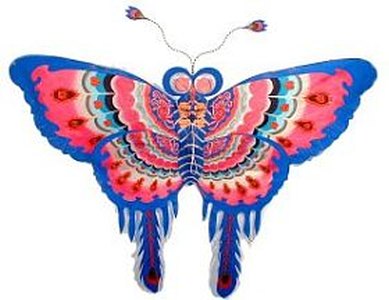- Home Page
- Asian Kites
- Chinese Kites
- Making ...
Making Chinese Kites
It's Hard to Find the Real Deal
There's plenty of general info on making Chinese kites if you browse around the Web. Like, you need some bamboo and a sheet of paper, nylon, or silk! But strangely, no-one seems to have published any in-depth step-by-step guide to making authentic Chinese kites.
 Chinese butterfly
Chinese butterflyJust about everything relates to simple classroom exercises where children make "Chinese-style" kites from straws and paper and so on.
Oh! Look at little Johnny's finger-painted Chinese kite! There's plenty of school teacher material but very little for someone who wants to recreate the real thing. Me think it 'mazing. :-/
If you're really serious about making Chinese kites, maybe try asking around in the Chinatown section of your nearest big city, and apprentice yourself to a master kite-maker. If you can find one. ;-)
On a more serious note, a good search on various social media could turn up some authentic Chinese kite-making activity. Perhaps even some step-by-step instruction might appear.
On this site, there's more kite-making info than you can poke a stick at. :-)
Want to know the most convenient way of using it all?
The Big MBK E-book Bundle is a collection of downloads—printable PDF files which provide step-by-step instructions for many kites large and small.
Every kite in every MBK series.
What I can share with you are the four stages to making real Chinese kites. A typical paper flat kite would use this procedure, for example a butterfly kite:
First, some suitable lengths of bamboo need to be selected. I went to a kite festival once, and some Taiwanese guys from the Yinlin Kite Club were using Taiwan Makino bamboo. The bamboo is pared off with a sharp knife, thin enough to flex to the required shape or outline of the kite. The kite frame is made by gluing or otherwise attaching together a number of bamboo strips.
Second, paper is cut to shape and pasted onto the frame. Not just any paper, though, it has to be "tough and thin with even and long fibers." This is probably not available from your local newsagent!
Third, the paper is hand painted with the desired design. Some designs also call for chiffon or cotton ribbons to be attached—either purely as decoration or for a tail in some cases.
Fourth, the bridle needs to be made and attached to the right spots. If you have made other kites before, a little experimenting should result in a happily flying Chinese kite!
Many Chinese kites use nylon cloth, while the best and priciest use silk cloth.
Imagine being involved in building a big dragon kite. Although they come in a large range of sizes, the construction method is pretty much the same. To a complex three-dimensional head is added a looooooong stack of simple flat kites that give that "centipede" look when high up in the air. Sorry, I don't have any dragon-kite plans to offer here just yet.
As mentioned earlier, there's more kite making on this site than you can poke a stick at. :-)
Want to know the most convenient way of using it all?
The Big MBK E-book Bundle is a collection of downloads—printable PDF files that provide step-by-step instructions for many kites large and small.
That's every kite in every MBK series.
